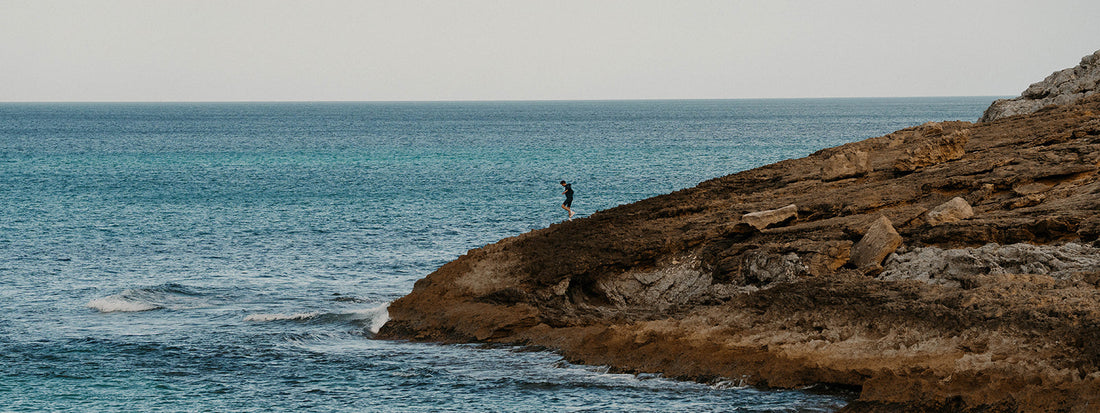In 1968, the crew of the Apollo 11 was the first people to see the earth in its entirety. Astronaut Michael Collins describes the earth as follows: "I had a feeling it's tiny, it's shiny, it's beautiful, it's home, and it's fragile ."
This year's IPCC report has once again proven how fragile our home planet is. The leading climate scientists made a clear statement in the IPCC report: We will not achieve the Paris Agreement targets (1.5° warming) if we do not reduce our emissions now. To meet the Paris Agreement's 1.5 degree target, the world must cut its carbon emissions by 50% by 2030 or we will set off irreversible chain reactions.
For us at RYZON, environmental awareness has been part of our DNA since day one. Because as athletes we are at home outside, whether on the bike, running or swimming.
We want to be part of the solution, but we also know that this is a very complex issue. It requires many steps. We don't just want to talk about it, we want to act. "Talkers talk, walkers walk" – that's the saying.

Together with Climate Partner, we have worked hard to reach this big milestone for our still young company. We can proudly announce that RYZON's head office has completely offset its CO2 emissions through a financial climate contribution. We know that this is just the first step on a long journey. True to our motto "Chase the horizon", we are sure that the long climb will reward us with a subsequent view of the horizon.
In this blog post, we take you on our journey to a better future by explaining what we do, how we do it and what our future plans are.
What are we actually talking about here?
Before we talk about measures, we need to clarify some terms that come up again and again:
What is a CO2 equivalent (CO₂e)?
A CO₂ equivalent (CO₂e) is a unit of measurement used to standardize the climate impact of different greenhouse gases. ( further information )
What is CO ₂ compensation?
This is any activity that offsets the emission of CO₂e by reducing emissions elsewhere. A distinction must be made here between CO2e avoidance and CO2e neutralization. If, for example, wind turbines are built, CO2e is saved, but no CO2e is removed from the atmosphere. Co2 neutralization can be achieved, for example, through reforestation or peatland rewetting. ( further information )

How do we offset our emissions?
Now that we agree on the terminology, let's dive deeper into our actions. It is not easy to count and record the emissions for an entire company. In order to count emissions, they are divided into three different areas.
Scope 1 describes all emissions from sources that we directly own or operate. An example of this would be our company vehicles.
Scope 2 includes all emissions based on the energy purchased to operate our business. Examples of this are electricity or heating.
Scope 3 includes all emissions caused by activities that are not directly owned by us but are nevertheless important to our business. An example of this is the manufacturing process of our clothes.
We decided to focus on ourselves first. We can directly influence this area. In practice, this means that we offset the emissions from the company's own vehicle fleet and the building management at our headquarters.

Here you can find more information about the three scopes.
where we equalize
One of the most difficult steps is deciding who we want to help with our offsetting. There are many great initiatives around the world. That is why we have relied on the framework of the Sustainable Development Goals (SDGs) at this point.
The 17 Sustainable Development Goals (SDGs) formulate a common path to peace and prosperity, for people and planet, now and in the future. They recognize that eradicating poverty and other disadvantages must go hand-in-hand with strategies to improve health and education, reduce inequality, and boost economic growth — all while tackling the climate crisis and protecting our oceans and planet forests.
The graphic below shows the different impact levels of the goals. Below are the goals relevant to the Earth's biosphere. The middle level represents all SDGs that relate to social goals, while the top level depicts the economic goals. The graphic shows that the ecological goals are the cause of the other problems. In order to achieve the social and economic goals, we must first focus on the goals that affect our biosphere. For this reason, after careful consideration, we have selected a reforestation project that has a direct impact on the first level: Goal 15, Life on Land.

The climate crisis affects the whole world, including our home country Germany. That's why we decided to support a local project. According to the international framework of the Paris Climate Agreement, local climate protection projects are not sufficient for compensation, since local climate protection projects are already counted towards the national emission reduction targets in Germany.
That's why we decided on a dual project. The dual project enables us to support projects in Germany and offset our emissions with another project in the Brazilian state of Pará. In this way we can guarantee CO2 neutrality for ourselves and at the same time promote local climate protection. You can find the project in Germany here . You can find the project in Pará here .
Our next steps
After measuring our emissions for the first time this year, we want to find ways to further reduce our emissions. At the same time, we want to continue using our platform for projects like United in Humanity .
You may have noticed that Goal 13: Climate action is one of the key SDGs because it can drive real change and influences all other aspects of the framework. We want to take the next steps together with you as part of our community. So we've put together a small list of resources to help you learn more about the topic.
// What is the environmental footprint of our clothing and what can we do to change it? Here you can calculate your fashion environmental balance.
// We all know that flying is bad for the earth, but what must we do to compensate for our own flight? Atmosfair is a simple platform that allows us to calculate our own flight emissions.
// Books, movies and more
o Penguin's The Green Idea book series
o Our Planet (movie)
o Seat at the Table by Jack Harries (series)
// In addition, there are already many inspiring people who are committed to a better world. These are two of our favorite environmental influencers:
o earthbyhelena
o earthrise.studio


